Step-by-Step: How to Scrape Prices from Websites for Beginners
8 min read
8 min read

Table of Contents
Table of Contents
In today’s digital world, knowing how to scrape prices from websites is a valuable skill. Whether you are running a business, carrying out marketplace research, or simply trying to find the best offers, price scraping can offer crucial insights. This guide will provide a top-level view of web scraping basics, the essential tools required, and the recommended best practices to adhere to. Let’s dive in and discover how to scrape prices from websites efficiently and legally.
Web scraping is the process of using automated bots to extract data from websites. This data can then be used for various purposes, such as price comparison, market research, and price optimization. Web scraping can help you gather large amounts of data quickly, making it a powerful tool for anyone needing accurate and up-to-date information.

Scraping prices from websites can offer numerous benefits:
Before you start scraping prices from websites, you need to have the right tools and a clear understanding of the process. Here’s a step-by-step guide to help you get started:
Several web scraping tools are available, each with its features and benefits. Here are some popular options:
Choose a tool that fits your technical skills and scraping needs.
Before scraping any website, it is essential to understand the legal implications. Not all websites allow scraping, and violating their terms of service can lead to legal issues. Here are some excellent practices:
After selecting your tool and familiarizing yourself with the legal considerations, the next step is to configure your scraper. Below is a fundamental example utilizing Python and Beautiful Soup.
After setting up your scraper, you’ll need to extract and store the data in a useful format. You can save the data in a CSV file, a database, or any other format that suits your needs. Here’s an example of how to store data in a CSV file using Python:
Websites often change their structure, which can break your scraper. Regularly update your scraper to ensure it continues to work correctly.


To scrape prices from websites effectively and ethically, follow these best practices:
Consider using a price scraping API or building a price scraper bot for more advanced scraping tasks. These tools can provide more robust and scalable solutions for large-scale scraping projects.
A price scraping API allows you to fetch pricing data from various websites without building and maintaining your scraper. Some popular APIs include:
If you have advanced coding skills, you can build a price scraper bot to automate the entire process. Here’s a simplified example using Python and Selenium:
Web scraping presents various challenges. Below are some typical problems along with their corresponding solutions.
Learning how to scrape prices from websites can be a game-changer for your business or personal projects. By following this guide, you’ll be able to gather valuable pricing data efficiently and ethically. Remember to choose the right tools, respect legal guidelines, and follow best practices to make the most out of your web scraping efforts.
Whether you’re conducting market research, optimising prices, or simply looking for the best deals, web scraping can provide you with the data you need.
Web scraping for prices involves extracting pricing information from websites using automated tools. It helps gather data for comparison, market research, or e-commerce analysis.
Beginners can start by choosing a scraping tool or library, identifying the target website’s structure, and writing a script to extract the desired pricing data.
Web scraping is legal as long as it complies with the target website’s terms of service. Always review the website’s policy and consider data usage regulations.
Best practices include respecting website policies, managing request rates, handling data efficiently, and ensuring compliance with legal and ethical standards.